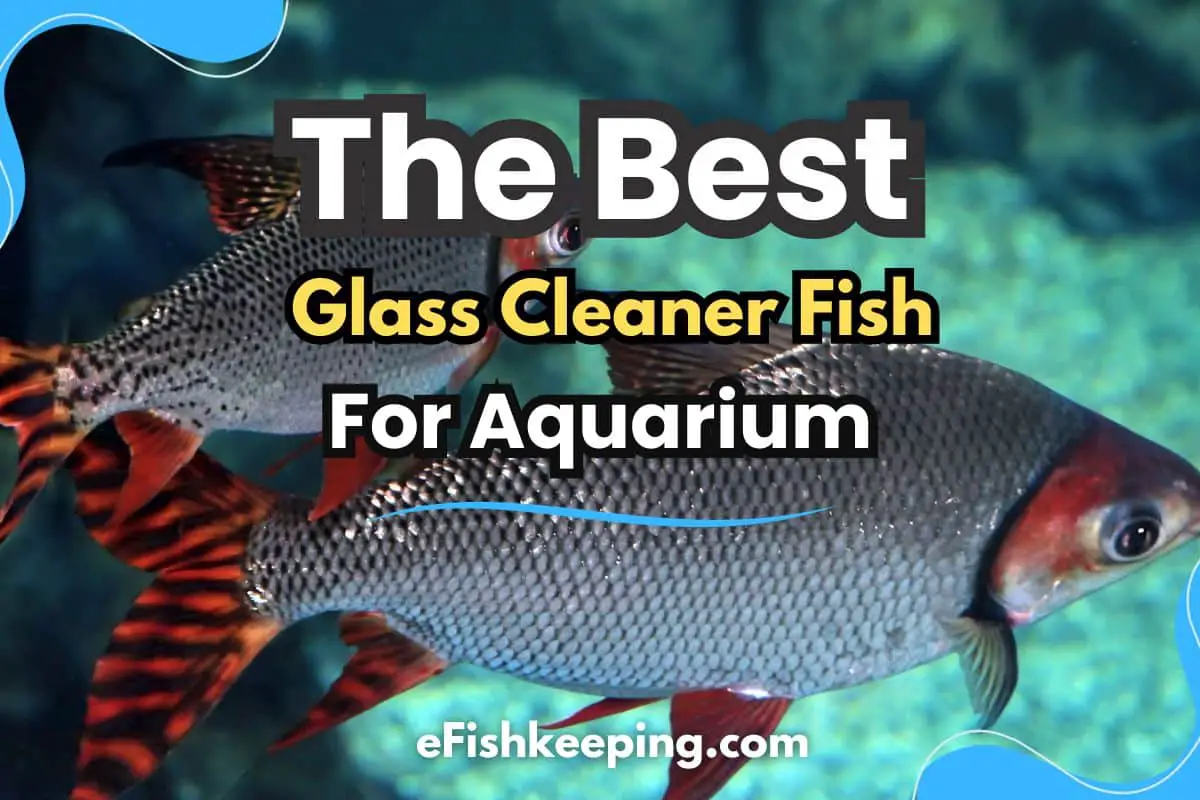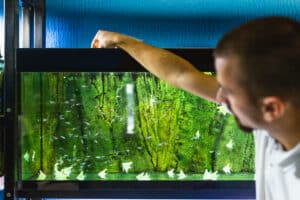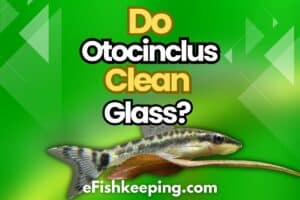We have 3 fish tanks in our home.
And in one of them, we often had some algae problems – especially on the glass surface.
But all of that changed after we added these two fish:
- Flag Tail
- Golden Algae Eater
In the past, we also had Pleco and ahead in this post I’ll talk more about it.
But frankly, plecos tend to produce a lot of waste in the tank than the clean up they do. So the Flagtails and Golden Algae Eater are the best options.
Other than that, I also love Otocinclus Catfish. I haven’t tried them yet in our home fish tanks, but I’ve heard a lot of good things about them for their tank cleaning capabilities.
So without further ado, let’s jump straight in and explore more about each of these fish.
#1. Flag Tail – The Best Glass Cleaner Algae Eater
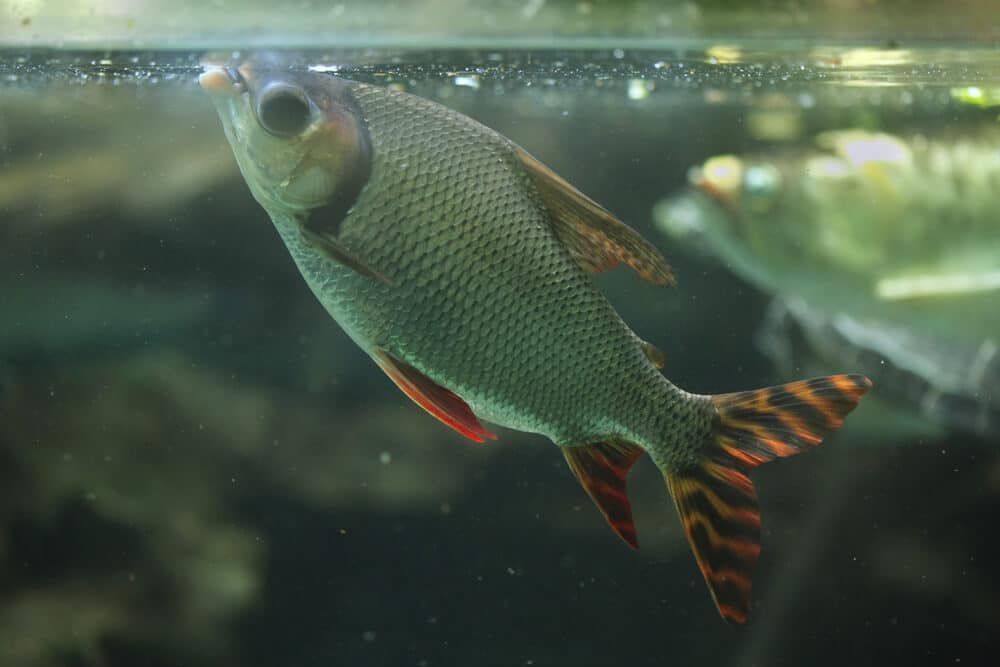
Quick Overview:
Flag Tails also known with other names like “Flagtail Prochilodus” or “Semaprochilodus taeniurus” are popular freshwater fish. In nature, they are found in the Amazon river basin in South America.
These fish are popular in the aquarium hobby for their algae eating behavior. And I can say this based on my personal experience.
These fish have special mouth structure like a vacuum hose which allows them to quickly grab microscopic algae from any surface.
After we put them in our tank, we noticed a considerable change in the amount of algae in our tanks.
At first, we used to notice our tank getting dirty and that greenish appearance within 2-3 weeks.
But now, even after a month, whenever we take a quick glance at our tank, it feels just like we did the water change only a few days ago. Interesting, huh?
What Do They Eat?
- Type: Omnivores but mainly prefers plant-heavy diet
- Algae (their favorite food)
- Spirulina
- Dried Foods
- Frozen Foods
Water Parameters:
| Parameter | Suitable Range |
| Temperature | 24°C – 28°C (75°F – 82°F) |
| pH | 6.5 – 7.5 |
| General Hardness | 50 ppm – 150 ppm |
What Size Tank?
- Grow up to 10 inches – 14 inches
- Minimum 10 gallons
- Prefers 20+ gallon tank
How To Take Care?
- Keep in groups of 5-6+
- Provide plenty of algae for grazing
- Offer supplemental foods like veggies and algae wafers
- Maintain good water quality
Temperament:
Very Peaceful toward other fish. Best kept with small, peaceful tank mates. Their unique appearance and feeding activity using their special mouths is really fun to watch. You will be amazed by their calm behavior – because I’ve experienced it 😉
Tank Mates:
- Compatible: Angelfish, Cory Catfish, Mollies, Tetras, etc. type of peaceful fish
- Incompatible: Any aggressive fish such as super active Cichlids
#2. Golden Algae Eater – The Best Active Glass Cleaner
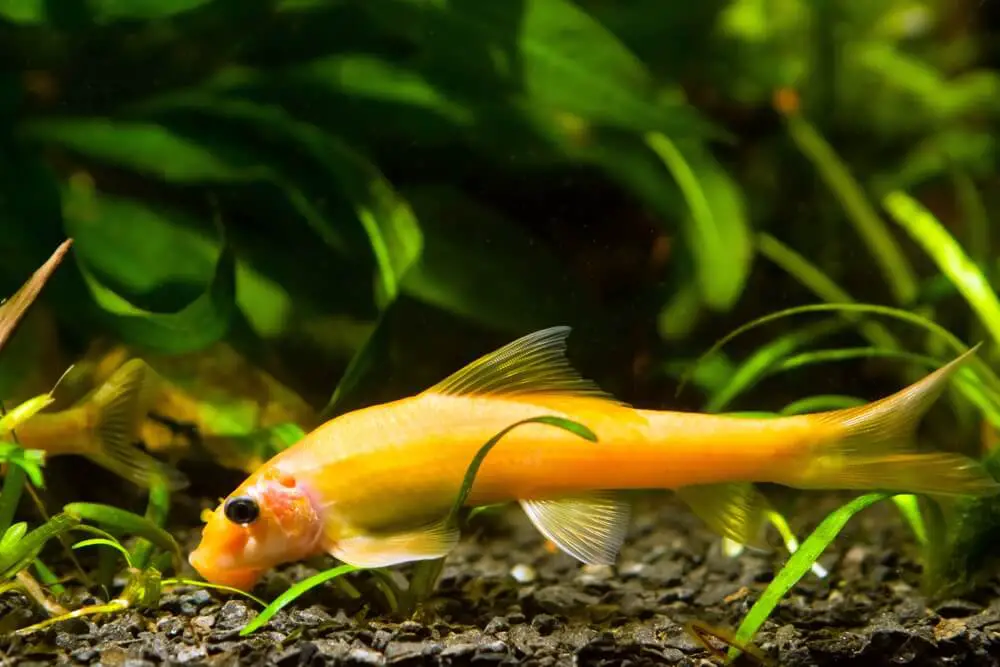
Quick Overview:
The Golden Algae Eater, is a lively bottom-dwelling fish that eats algae from the glass surface.
It also has that special pleco-like sucking type mouth which allows it to suck up all the algae present on the aquarium glass surface.
It is a super active fish. One moment, you’ll see the guy resting on a cave top inside the tank and the next moment… he will be right in front of your face sucking up all the algae from the tank glass – up and down before it goes again… quite a fun to watch, haha!
If you’re like us who love to have at least some motion and energy going on in the tank, then you’ll love golden algae eater fish. That’s why we add it to our tank.
Also Check Out>> How Many Algae Eaters Can Be Added In A Tank?
That said, there is one thing to keep in mind, sometimes if it doesn’t find a good amount of algae or leftover foods, it may start sucking up on the body of some fish itself. I haven’t noticed this often, but it can happen sometimes. This usually happens if you house it with those big calm and gentle fish such as discus.
But we’ve been keeping it with angelfish, flagtail fish, corys and a whole lot more, and we haven’t noticed any issues. Still, it’s best to avoid keeping them with any flat bodied fish like angelfish or discus fish.
What Do They Eat?
- Diet Type: Omnivores
- Algae
- Leftover Fish Food
- Daphnia
- Bloodworms
- Zooplankton
- Bacteria
Water Parameters:
| Parameter | Suitable Range |
| Temperature | 74-80°F (24-27°C) |
| pH | 5.8-8.0 (Ideal 6.5-7.5) |
| Carbonate Hardness (KH) | 8-10 |
| General Hardness (GH) | 3-12 |
What Size Tank?
- Average size 5 inches but can grow up to 10 inches
- 30 gallons in general but you can also keep the young ones in 10 gallons tank
How To Take Care?
- Keep solo or in small groups
- Provide plenty of rocks and driftwood
- Feed vegetable matter and supplements
- Maintain excellent water quality
Temperament:
Peaceful but active. Will rapidly dart around tanks grazing on algae. Best housed with peaceful, non-aggressive tank mates.
Tank Mates:
- Compatible: Zebra Danios, Mollies, Angelfish, Cory Catfish, etc peaceful and active fish
- Incompatible: Discus fish, Angelfish, and even Goldfish (house any fish that is slow to react – the golden algae eater will take the advantage and start eating and sucking its surface slime layer!)
Overall, it’s a great fish to control glass algae and keep it spotless.
#3. Pleco – The All Time Favorite And Classic Glass Cleaner Fish
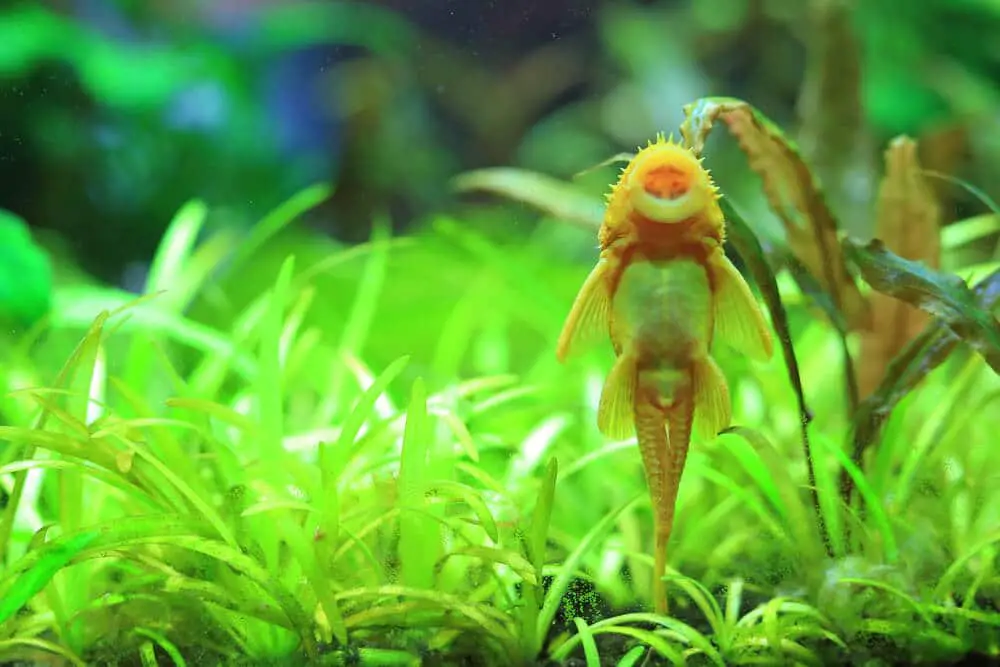
Quick Overview:
The Pleco, or Plecostomus, is a classic favorite among aquarium enthusiasts for its impressive glass-cleaning abilities.
Known for its distinctive sucker mouth, the Pleco is excellent at removing algae and keeping your aquarium’s glass spotless.
In one of our tanks, we had a pleco that cleaned the tank very effectively. He used to swim around constantly near the driftwood and cleaning the glass surface of the tank.
He used to even dip his streamlined body inside cavities and holes of the decoration to suck up that dirt or algae.
But unfortunately, housing plecos means being prepared for frequent water changes. One the one hand they help in cleaning the glass clean. But they also add a lot to the bioload of the tank.
Plus, they grow up in size quickly and you’ll also need a bigger tank to house them.
But all in all, if you have a big tank of at least 30 gallons or more, then it’s nice to have them in the mix. It’s cool to watch them glide across the tank with other tank mates and see them in action.
What Do They Eat?
- Diet Type: Omnivores, but they mostly prefer herbivorous diet
- Algae
- Plant matter like Zucchini, Lettuce
- Live foods
- insects
Water Parameters:
| Parameter | Suitable Range |
| Temperature | 22–30°C (72–86°F) |
| pH | 6.5–7.5 |
| Hardness | 20–35 dGH |
What Size Tank?
- 20-30 gallon minimum when young
- 75+ gallons for full grown common Pleco
How To Take Care?
- Provide hiding spots and shaded areas
- Give vegetable matter and add driftwood (because they love munching on the wood all day long)
- Maintain excellent water quality
- Avoid sharp decorations
Temperament:
Peaceful bottom dwellers great for community tanks. Doesn’t bother any fish in the tank. But they can quickly grow in size and start consuming more space if you have a compact tank size.
Tank Mates:
- Compatible: Tetras, rasboras, cory cats, gouramis, livebearers
- Incompatible: Aggressive fish like Cichlids or fish small enough to be eaten
#4. Other Glass Cleaner Fish For Aquarium – Otocinclus Catfish
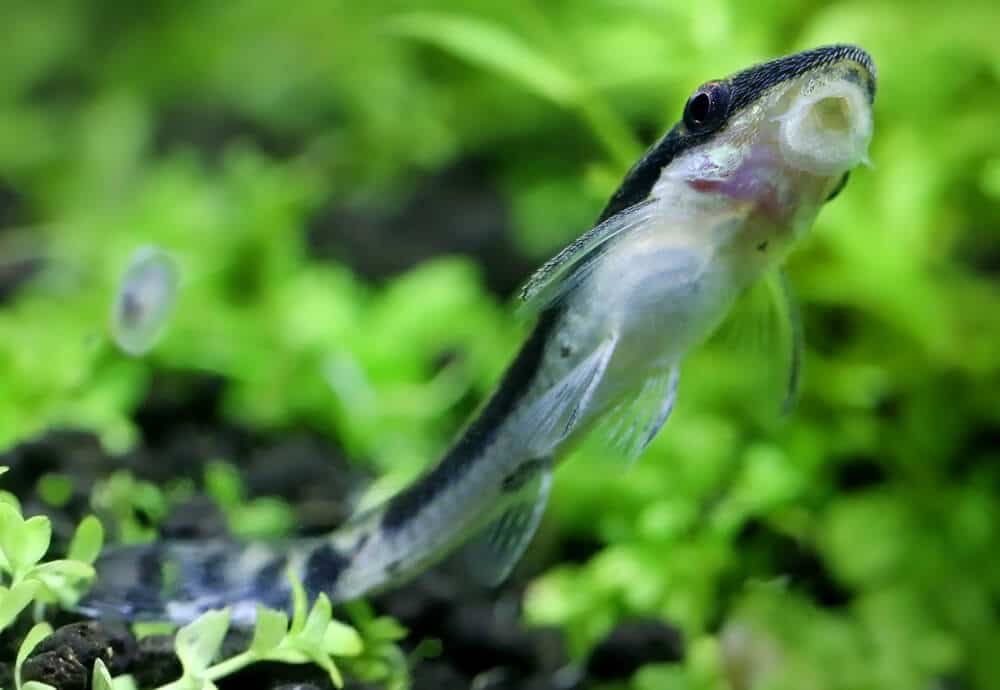
Quick Overview:
Otocinclus catfish, also called Otos, are small peaceful algae eaters perfect for cleaning aquarium glass. Their tiny size and community-friendly nature makes them a great addition to any fish tank.
Check out this guide on how effective Otocinclus are in cleaning glass.
What Do They Eat?
- Diet Type: Primarily herbivores.
- Algae
- Zucchini, Lettuce
- Algae wafers
Water Parameters:
| Parameter | Suitable Range |
| Temperature | 22–26°C (72–79°F) |
| pH | 6.8–7.5 |
| Hardness | 7–15 dGH |
What Size Tank?
- They grow up to 2 inches.
- At least 10 gallons
- Gow better in larger tank of at least 20-30 gallons especially since they prefer being in groups of 6 or more
How To Take Care?
- Love planted tanks with plenty of hiding spots.
- Keep the water clean and well-oxygenated.
- Give vegetable matter
Temperament:
Peaceful and shy bottom dwellers. They mostly stick to the tank’s glass and plants, busy nibbling algae.
They’re not just effective algae eaters; they’re also super calm and add a dynamic aspect to your tank without causing any trouble.
Tank Mates:
- Compatible: Small, peaceful fish like Tetras, Guppies, and Dwarf Gouramis.
- Incompatible: Large, aggressive fish or fin-nippers that can stress them out.
Final Thoughts
Having the right algae-eating fish is the most effective and low-maintenance way to keep your aquarium glass spotless.
The Flag Tail, Golden Algae Eater, Pleco, and Otocinclus Catfish are top choices that will constantly graze on algae without bothering other tank mates.
By following the care tips explained for each fish, you can ensure they grow and maximize their glass-cleaning talents.
FAQs
How Often Should I Clean My Aquarium?
For most tanks, aim to clean 15% of the water bi-weekly. Scrub algae off glass and do filter maintenance monthly. Deep clean substrate and decor every 3-4 months for best tank condition.
What Are Best Algae Eaters Other Than Fish For Cleaning Fish Tank Glass?
Nerite snails, shrimp like Amanos are great non-fish options for eating algae off glass. An algae scrubber brush like this one (available on Amazon) also helps manually clean glass.
How To Get Rid Of Algae From Fish Tank Glass?
Clean glass manually by scrubbing it off weekly at water changes. Reduce tank lighting duration to 6-8 hours max. Add fast growing plants to use up nutrients algae needs. Supplement tank cleaner crew with algae eaters.
Hi! I’m Praveen Ghoshal, the founder of eFishkeeping.com. Inspired by my Dad, I got interested in fishkeeping when I was a kid. Since then, I have been involved with this hobby. Currently, I have 3 fish tanks at our home, and I enjoy this hobby with my full family. Read more about me here.

